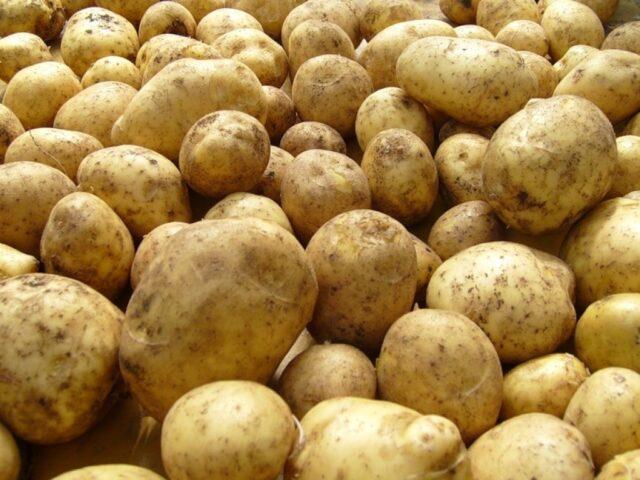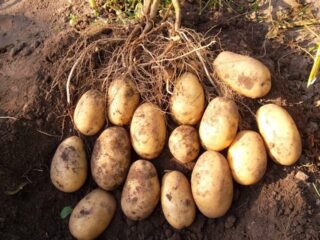Content
In addition to the usual table potatoes, which are the basis of the human diet, there are also fodder potatoes intended for fattening livestock. This type of crop is widely in demand in agriculture, as it is highly nutritious and contributes to the rapid weight gain of domestic animals. All varieties of fodder potatoes are characterized by high productivity. This allows you to significantly save on the consumption of other feeds.

Growing fodder potatoes is the same as growing table potatoes
What does fodder potato mean?
The fodder type of crop perfectly complements the grains and concentrated mixtures that make up the diet of animals. It allows you to make it more balanced and thus increase the yield of the finished product, as well as improve the quality of the meat. It is recommended to feed feed potatoes to pigs, large and small livestock raw, but well washed. But it can only be fed to poultry and rabbits in boiled form.
What does fodder potato look like?
It is not easy to identify fodder potatoes by their appearance. Because it is not much different from the dining room. But there are still some features.
Feed tubers are very large and one-dimensional. Their size is 2-3 times larger than that of table species. This explains why fodder potato varieties are more productive. Their tubers have the shape of an irregular oval or circle with protruding areas in different places. The eyes of fodder potatoes are deep-set and the skin is rough. And on the cut you can see the snow-white pulp, which is too juicy.

The feed type of crop is absorbed in the pig’s body by 90-95%
Difference from table potatoes
The difference between table and fodder potatoes lies in their taste properties. This is due to the fact that the latter has a high content of starch, protein and dry matter. Therefore, the feed type is more caloric and nutritious, which ensures accelerated growth of animals.
The contents of the main components in it:
- starch – more than 18%;
- ascorbic acid – does not exceed 18%;
- protein – 2-3.65%;
- digestible protein – 1.6%.
Pros and cons of fodder potatoes
Fodder potatoes have their pros and cons. Therefore, when growing it and further using it for fattening livestock, you need to study them in advance.

The nutritional value of feed potatoes is 0.31 feed units
Main advantages:
- high stable yield;
- suitable for long-term saving;
- easy to transport;
- accelerates the process of weight gain in animals;
- reduces livestock maintenance costs;
- has increased nutritional value;
- does not require complex care;
- little susceptible to pests and diseases;
- improves meat quality.
Flaws:
- tops and tubers contain solanine, which gives bitterness to milk;
- the concentration of nutritional components decreases during long-term storage;
- When using ensiling, the acidity level in tubers increases.
Fodder potato varieties with photos and descriptions
There are many types of fodder potatoes. They have certain differences between themselves. However, there are several varieties that are very popular in agriculture. Therefore, in order to make the right choice, it is worth considering each of them separately.
Berlichingen
This German fodder potato variety is also popularly called Berlinka. Developed in 1923 by crossing the Pepo and Centriole species. It is considered a medium ripening species. The duration of the growing season is 90-100 days from the moment of emergence. Under each bush, 7-12 tubers are formed, weighing 80-150 g.
The peel is uniformly red in color, the flesh is snow-white, and does not darken when exposed to air. The starch content in tubers is 14-17%, therefore it is considered a universal variety. Recommended for cultivation in northern regions. The yield is 220-400 centners per hectare.

In Berlichingen the tops go down at the end of the growing season
Zazersky
It is considered a table and fodder variety. It is characterized by high resistance to late blight, scab, and potato cancer. The taste of the fruit is satisfactory. The tubers are round, light yellow in color, the flesh has a paler shade. The peel is smooth, dense, and less susceptible to mechanical damage. The eyes are set deep.
This fodder variety is recommended for cultivation in Russia, Ukraine, and Moldova. The starch content in tubers reaches 14-18%.

The productivity of Zazersky potatoes is 220 centners per 1 ha
Voltman
A late variety of fodder potatoes, characterized by a high content of nutritional components. It is undemanding to growing conditions and care, and has good shelf life. The tubers are large, irregularly rounded, angular. The peel is dense, red with numerous light eyes. The pulp is juicy, white, contains up to 20% starch.
This variety is widespread in Uzbekistan. It is resistant to blackleg and ring rot.

The duration of the growing season for Woltman potatoes is 110-120 days
Vita
The variety belongs to the table-fodder category, as it is characterized by good taste and excellent presentation. The tubers are round, white in color. The eyes of the Vita variety are sparse and superficial. The peel is thick, dense, smooth, and becomes slightly reticulated in dry seasons.
The fodder variety Vita is widely distributed in Russia. Ukraine, Moldova. It is resistant to cancer, but suffers moderately from late blight, blackleg. The yield is 300-400 centners per hectare.

Potato Vita is affected by common scab
Lorch Lorch
An ancient forage variety, which was bred in 1922 by crossing the species: Svitez and Smyslovsky. The duration of the growing season from the date of planting is 100-120 days. The tubers are round-oval, large, weighing 90-120 g. The peel is strong, smooth, but there is peeling in the upper part of the potato. The pulp is white, with a greenish tint. The eyes are small and superficial. Up to 12-16 potatoes are formed under each bush.
The fodder variety Lorch Lorch is not affected by rust or viruses. But it is susceptible to late blight, cancer, golden nematode, and ring rot. The yield is 250-350 centners per hectare.

Lorch variety Lorch is not picky about soil composition
Korenevsky
Mid-late type of fodder potato. The duration of its growing season is 100-110 days from the moment of planting. Under each bush, up to 10-12 tubers are formed per season, weighing 90-120 g. The color of this fodder potato is white, the flesh is the same shade. The starch content in tubers is 13-20%. The variety easily tolerates heat without loss of productivity.
Korenevsky potatoes are common in Russia and Ukraine. Moldova. It is resistant to late blight and mosaic, but is affected by blackleg and cancer. Productivity is about 250-350 kg per 1 ha.

Fodder potatoes Korenevsky are characterized by low maintenance
Adretta
This table and fodder crop species was bred by German breeders and entered into the State Register more than 40 years ago. But it still remains relevant due to its high productivity. The Adretta variety belongs to the category of mid-early species with a growing season of 60-80 days from the moment of emergence. The starch content in its tubers reaches 13-18%. Average fruit weight is 100-150 g.
Potatoes are round, yellow in color and have white flesh. They have good taste. Adretta potatoes have excellent keeping quality. The variety is susceptible to golden nematode. It easily tolerates drought and temperature changes.

Under the Adretta bush, 12-15 tubers are formed
Kameraz
A mid-season forage crop variety whose growing season lasts 90-110 days from the moment of germination. It has a high starch content in the range of 14-18%.The tubers are round and white. The peel is smooth, the depth of the eyes is average. The starch content in potatoes is 12-16.6%.
This fodder potato is resistant to cancer, but is moderately affected by late blight. The variety is zoned for the central and northern regions, undemanding to soil composition and care. The harvested crop is well preserved until the new season.

Camerase does not respond well to drought
Ostboth
This species is characterized by average taste and high content of nutritional components. Productivity reaches 280-380 centners per 1 ha. Root vegetables are yellow in color, round-oval. The peel is thickened, dense, rough. The depth of the eyes is average. The starch content in potatoes reaches more than 18%.
Ostbothe fodder potatoes are affected by late blight and scab, but are resistant to cancer. The variety is zoned in the central regions.

Ostbots will maintain productivity even in unfavorable seasons for the crop
Belarusian starchy
Belarusian variety, the starch content of which reaches 20.7-21.2%. Under each bush, up to 12-15 rounded tubers weighing 100-120 g are formed per season. The peel is dense, rough, and little susceptible to mechanical damage. The depth of the eyes is average. The pulp is white, juicy.
This fodder variety is resistant to cancer and late blight, but may suffer from scab and rhizoctonia. The duration of its growing season is 90-110 days. Productivity reaches 320 centners per hectare.

Belarusian starchy easily tolerates transportation and long-term storage
Conclusion
All varieties of fodder potatoes are suitable for feeding animals, are stored and are characterized by a high level of productivity. However, it is worth considering that for large and medium-sized cattle they can only be considered as an addition to the main diet, but for pigs and poultry they can be the basis of the diet.








